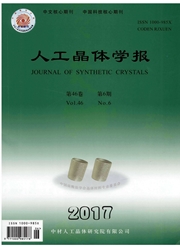

 中文摘要:
中文摘要:
以TiOSO4为钛源,采用阳离子交换、原位水解、原位脱羟技术制备了TiO2/蛭石纳米复合物。采用XRD、FTIR、FSEM等对TiO2/蛭石纳米复合物制备过程产物包括聚合羟基钛离子-蛭石、水合氧化钛/蛭石复合物以及TiO2/蛭石纳米复合物的结构、微观形貌等进行了表征和研究。结果表明:在pH值较低时,TiOSO4溶液中的聚合羟基钛离子通过阳离子交换作用进入蛭石层间域中,随着pH值逐渐升高,进入层间域中的聚合羟基钛离子水解聚合形成水合氧化钛,蛭石的层间域被撑大,有序性结构被破坏;经900℃热处理后水合氧化钛脱水形成TiO2/蛭石纳米复合物;样品中TiO2含量随结束pH值的升高而增加,并均匀地插入蛭石的层间域中或分布在蛭石片层的表面;与纯TiO2纳米粉体相比较,TiO2/蛭石纳米复合物结构中TiO2在900℃焙烧后仍未出现金红石相,表明蛭石结构层对TiO2的晶相转变具有明显的阻滞作用。
 英文摘要:
英文摘要:
The TiO2/vermiculite nano-composites were prepared by cationic exchanger,in situ hydrolyzing and in situ hydroxyl method using TiOSO4as a precursor of TiO2.The TiO2/vermiculite nanocomposite preparation products including polymeric hydroxy titanium ion-vermiculite,hydrated titanium oxide/vermiculite composites and TiO2/vermiculite nano-composite were characterized by XRD,FTIR and FSEM.The results show that polymeric hydroxy titanium ion in TiOSO4solution get into the interlayer of vermiculite by cation exchange function under low pH value.Then,with the pH value increased,the polymeric hydroxy titanium ion in the interlayer hydrolyzation and polymerization into hydrated titanium oxide,and vermiculite interlayer distance enlarged,ordered structure destruction.After 900 ℃ heat treatment the hydrated titanium oxide dehydrated to form TiO2/vermiculite nano-composites;TiO2content in the samples increased with the rising of ending pH value,and TiO2particles are in vermiculite interlayer distance or distributed on the surface of vermiculite flake evenly.Compared with pure TiO2nano-powder,there was no rutile at temperature of 900 ℃,this show that vermiculite layer structure has obvious retarding effect of TiO2crystal phase transition.
 同期刊论文项目
同期刊论文项目
 同项目期刊论文
同项目期刊论文
 期刊信息
期刊信息
